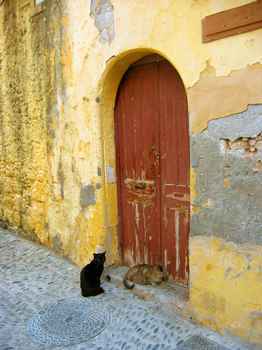
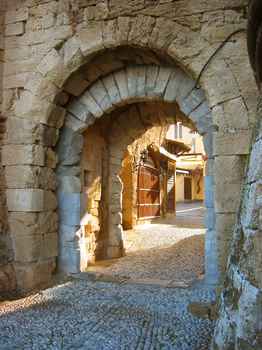
Greetings,
We arrived in Greece on the 22nd of March as we took a ferry across from Marmaris to Rhodes City on the island of Rhodes. As we walked off ferry and quickly brushed through customs, we visited an ATM machine and extracted our first "euros". We admired the new notes that so much fuss had been made about, and then walked towards the shore to search for a hotel.
Many of the hotels listed in our guidebook were closed, and finding our way through the maze of passages in the old city could have been a little daunting. Luckily, we were greeted by a tout with a reasonably priced room available, and he quickly led us to the room where we dropped off our bags.
The weather was beautiful on arrival, although it was late in the day and we were a little exhausted. We spent our first evening just sampling the town's medieval atmosphere as we tried to find a reasonable restaurant for our first retsina and our first Greek salad. The town of Rhodes has deep roots that go all the way back to the classical Greek civilization, and it was once home to one of the seven wonders of the ancient world ... the statue called "Colossus of Rhodes". However, much of what you see today is the result of the period when the island was controlled by the Knights of St. John who arrived in 1309 and ruled for 213 years. They built amazing fortifications that are still largely intact today, and the highlight of Rhodes for us was just walking around Europe's largest inhabited medieval town and enjoying its ambience.
Another interesting attraction for us were the cats. I had heard about the famous cats of the Greek islands, but I didn't quite realize how many of them there actually were. Wherever we walked, there were tiny feral cats sneaking about and mostly avoiding people at all costs. A few were friendly with us, and even more were friendly with the local butchers and fishermen who liked to throw treats to the cats.
 |
 |
| A couple of the cats of Rhodes. | A gate through a secondary wall in the city's defenses. |
The good weather that we enjoyed for our three weeks in Turkey was too good to last, and the half day of sun on our first day was one of the last sunny days that we would see for some time. We woke up the next morning to rainy skies, and went out in search of our morning breakfast. As we walked around town, we realized that something was a little different about the old city of Rhodes. The area within the city walls is quite large (almost a square kilometer), but there were almost no shops inside that seemed to cater to locals (and in fact, very few locals). There were lots of tourist shops and restaurants, but as it was still early in the season, most of these were either closed, or were undergoing some sort of renovation in order to get ready for the summer high season. Without tourist, locals, or shops, it was a bit of a ghost town.
This was a mixed blessing, of course. On one hand, it was wonderful to have the whole town to yourself. As you got lost in the narrow and twisty alleyways you could almost imagine what the town was like hundreds of years ago. However, it was also inconvenient at times that hotels and restaurants were closed, and bus and ferry schedules were cut back to almost nothing.
We ended up spending three days in Rhodes which was a bit shorter than we would have liked, but we were forced to match our schedule to that of the ferries. We passed our time strolling through the city when the weather was good, and inside Rhode's museums when it wasn't. One of the interesting museums is the Palace of the Grand Masters. It was built in the 14th century, destroyed during a gunpowder explosion in the 19th century, and then rebuilt by the Italians as a holiday home for Mussolini during the first half of the 20th century. The Italians appeared to spare no expense in the reconstruction, and the lavishly furnished rooms of the palace had stunning Greek and Roman mosaics as the centerpieces for each room. Some of the mosaics were from Rhodes, although most of them were raided from nearby islands such as Kos.
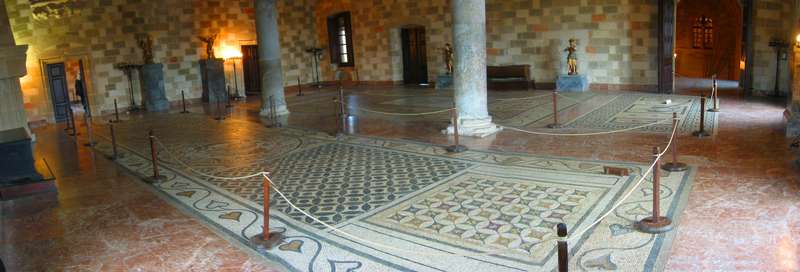 |
| A room in the Palace of the Grand Masters with some mosaics from the island of Kos. |
Down the street from the Palace are the Inns of the Knights of St. John. The Knights of St. John came from seven different countries, and each one of them had their own Inn where the knights lived and governed themselves. The regions were: England, France, Germany, Italy, Aragon, Auvergne, and Provence.
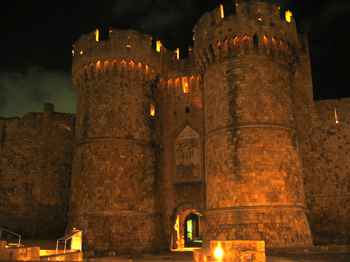 |
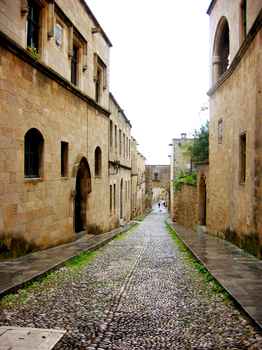 |
| Main gate to the town of Rhodes. | The Avenue of the Knights. |
The fortifications of the town were amazing, and it is a wonder that the Turks were able to overrun the town when they conquered it. There is a huge moat that surrounds the city which is divided by a large wall into an inner moat and an outer moat, very few entrances, and a large area inside the town which should have allowed the defendants to hold off a siege for some time.
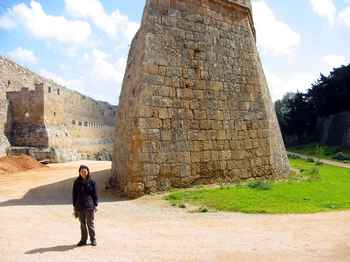 |
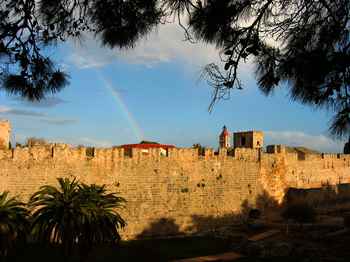 |
| A very thick wall separating the inner moat (to the left) from the outer moat (to the right). | A view of the inner wall of the city along with a rainbow ... taken from on top of the outer wall. |
The ferry schedule largely determined our schedule in the Greek islands, and we learned something interesting about ferries in Greece. Given the distances, they tend to run around the clock with their start and stop times optimized for being in Athens either in the morning or the evening. On all other islands, the ferry's arrival and departure was simply determined by the time that it took to get to or from Athens. In our case, the ferry would be leaving Rhodes at 4:30 am, and arriving in Crete at about 5 or 6pm. We were told that it wasn't even certain that the ferry would be leaving at all due to bad weather, but we couldn't find out for sure until the time of departure. So, we dragged ourselves out of bed at 3am, and were at the ferry the recommended one hour before departure, praying that the ferry would actually be leaving. It was drizzling somewhat, and there were large waves crashing in, but the ferry appeared to be getting ready for departure. Soon after we arrived, the ferry opened its gates and allowed the shivering passengers to board. The ferry was mostly empty which allowed us to stake out a comfortable little corner to rest in as we were rocked to sleep by the surprisingly large waves that managed to send spray past our window about 40 feet above the surface of the ocean. The rocking was intense enough at times that it was even difficult to walk. Thankfully, neither Hitomi or I became seasick (other passengers were not so lucky).
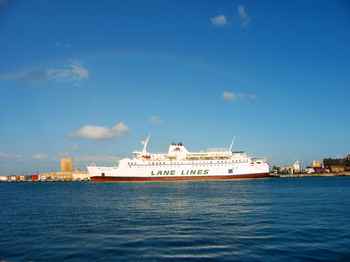 |
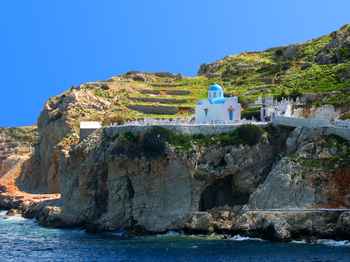 |
| The ferry that we took from Rhodes to Crete. | Church on a small island we stopped at between Rhodes and Crete. |
We arrived in Crete at a small town called Agios Nikolaos, where we found all of the hotels in our guidebook were closed down. However, while walking around town, we found a place with rooms to rent and a welcome escape from the rain. Agios Nikolaos has little going for it besides the fact that it is the destination of ferries from Rhodes, so the next morning we hopped on a bus and headed to Crete's capital city of Iraklio.
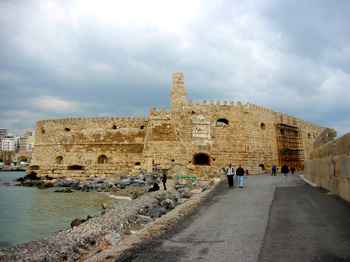 |
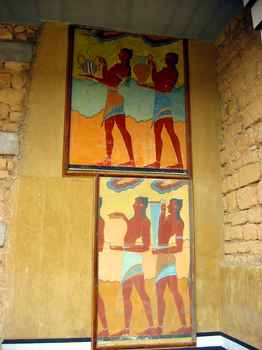 |
| Venetian fort in Iraklio, Crete. | Restored frescoes at the palace of Knossos. |
The main attractions of Crete are its history and museums, its nature, and its beaches. Given the time of the year, we decided to skip the beaches and nature and instead focus on its rich history. Crete is home to what is called the first advanced European civilization, known as the Minoans, who flourished between 2100 and 1400 BC and were the precursor to the ancient Greeks.
Outside Iraklio is the famed Minoan Palace of Knossos, and that was our first visit. We hopped on a packed local bus that wound its way through Iraklio before eventually terminating at the palace. We had nice weather to start out our tour, although that soon gave way to the familiar Greek showers. The ruins were impressive in that they were 3500 years old, although it was obvious that most of what was still standing was a reconstruction (and there are debates amongst archaeologists as to how accurate those reconstructions actually are).
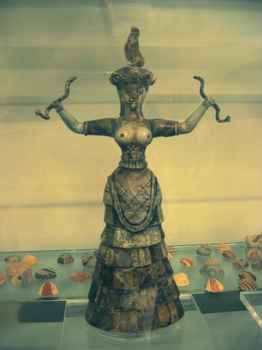 |
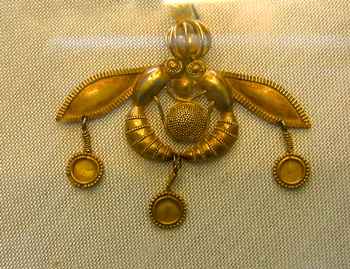 |
| Minoan snake goddess. | Minoan solid gold pendant (almost 3500 years old). |
More impressive to me was our visit to Iraklio's archaeological museum. There were stunning examples of art, and the art alone made it immediately clear how advanced the Minoan civilization actually was. The items included intricate jewelry, religious artifacts, clay tablets with written documents of business transactions, and beautiful frescoes depicting from the lives of the Minoans including scenes of wrestling, boxing, and acrobatics.
 |
| Former Venetian town of Rethymno on the island of Crete. |
Another excursion that we took was to Venetian built town of Rethymno. Crete was under the control of Venice from about the year 1210 until the late 17th century when it was taken by the Turks. While Iraklio had most of its historical buildings destroyed during World War II, Rethymno still has many of its buildings still intact, including those along its charming waterfront.
We later returned to Iraklio, and the next day we got ready for our next ferry ride to the island of Santorini. While not quite as inconvenient as a 4:30am start, the four hour ride to Santorini didn't leave until 8pm. This meant that we had to reserve a place to stay in Santorini ahead of time (and make sure that our host would still be awake at 1am). It also meant checking out of our hotel in the morning, leaving our bags at the lobby, and then killing time until the ferry left.
We managed to get a reservation at a Santorini hotel highly recommended by our guide, and our midnight arrival left us with the challenge of finding our hotel in the dark. The port at Santorini is about 5km from the main town of Thira, but busses, taxis, and touts meet every ferry, so we easily found our way into central Thira. That still left the task of finding the hotel which was located down a maze of windy paths and staircases. After a few wrong turns, we found our hotel just as it started to pour rain.
 |
| The view from our balcony in Santorini. |
The next morning we woke up to beautiful sunny skies. After four cold and partly rainy days in Crete, life began to feel much better again. Santorini is an island that was formed by volcanic activity. It erupted around 1650 BC in what is considered the largest eruption in recorded history. It spewed a column of ash 36km high in an explosion thousands of times larger than the atomic bombs of Nagasaki and Hiroshima, and sending out a tsunami 250m high. The explosion left a crater about 12km in diameter with parts of its rim under water. The largest part of the crater above water forms the half-circle island of Santorini.
Our hotel was perched right on the edge of a cliff in the town of Thira, looking down into the sea that now fills the center of the crater. Of course, we hadn't seen any of this in the darkness of the night before, but it was an amazing sight to wake up to, and we ended up spending five nights enjoying the views and the beautiful whitewashed towns of Santorini. There isn't actually a lot to do in Santorini. It has a small museum with some beautiful frescoes that were uncovered at a large Minoan town that was buried by lava in the eruption of 1650 BC. The best part of Santorini was just walking around and enjoying the views and the architecture, and following hidden little trails to see where they might end up. On one such trail, we hiked out to a bluff expecting the trail to end at the lookout. Instead, the path wound down the cliff on the other side until we dropped down to a beautiful little church. As opposed to the Catholics who enjoyed building grand cathedrals, the Greeks seemed to prefer to build small churches but to build them everywhere.
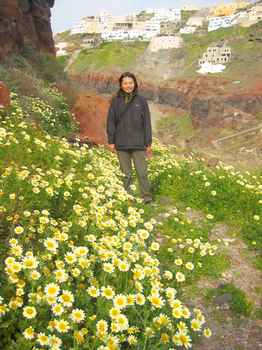 |
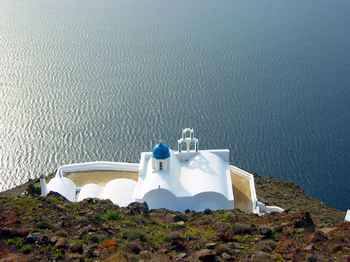 |
| Santorini wildflowers. | A hidden church on the cliffs of Santorini. |
Another fun excursion from our hotel in Thira was to a town on the tip of the island called Oia. As in Rhodes, the towns of Santorini almost felt like ghost towns as there were almost no tourists, few locals, and many shops were closed. This was especially true of Oia as we wandered around town and hardly saw a soul.
 |
| Santorini town of Oia. |
As in Thira, the town started at the ridge of the crater and sort of overflowed down its side with staircases going in every direction and feral cats always on the hunt. At one point we came across a team of donkeys that were hauling construction materials for the ongoing renovations. In the summer, the donkeys haul tourists up from the ports to the towns at the top of the crater rim. While this may seem like a grim occupation, I suspect the donkeys far prefer it to their winter tasks. The donkeys we saw were being loaded with large sacks of gravel. The sacks were heavy enough that it took three men to barely lift one of them, and the donkeys were loaded with two sacks each.
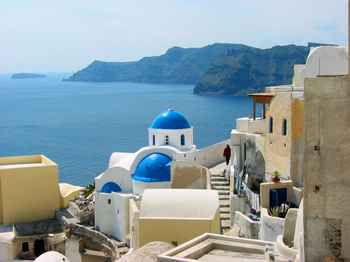 |
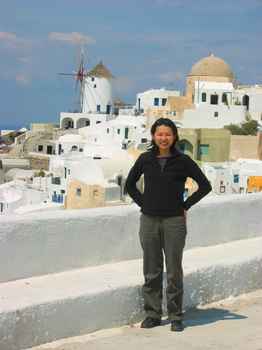 |
| Churches in Oia, Santorini | Windmill in Santorini. |
All good things must come to an end, and after a few days of marvelous weather, a winter storm blew through. Gale force winds blasted our room such that we could barely even open our door. Even this wasn't so bad however, as we ran out to the nearest bakery and had a nice little picnic in our cozy room while we worked on writing up our Turkey trip reports.
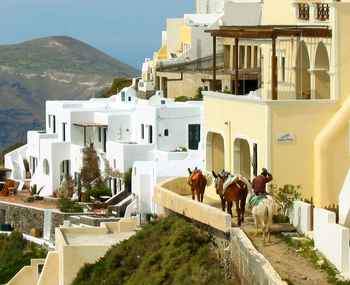 |
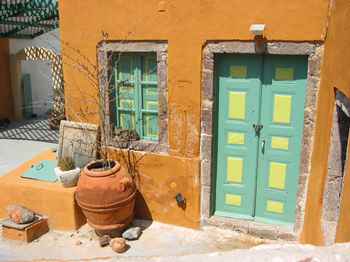 |
| Donkeys being put to work since there were no tourists to carry. | Santorini house (with a small cat on the windowsill). |
As our 5 days drew to a close, we got ready to get on yet another ferry. This time, however, the schedule was in our favour as we boarded a 8am ferry that had us in Athens by 6pm. We hopped on the metro, and found ourselves a budget hotel in the central part of Athen's tourist district. Athens is not a particularly pretty city with all its concrete and smog, although it is definitely worth visiting for a chance to see its Acropolis and its world class museum of archaeology.
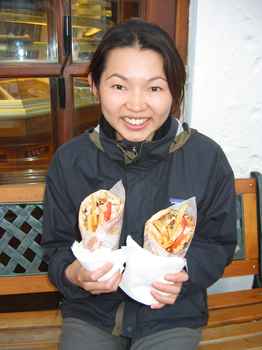 |
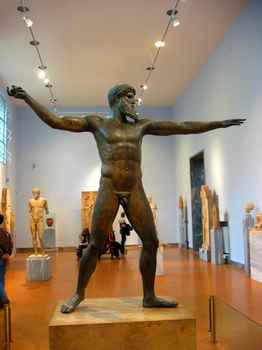 |
| Eating a chicken gyros (Greek fast food). | Statue of Poisiden in the Museum in Athens. |
Despite the raiding of the imperialist nations during the last few centuries, the Athen's museum still has the best collection of Greek artifacts complete with jewelry, marble, and a few bronze statues that weren't melted down by the invading tribes (mostly ones that were found on the bottom of the ocean). Its amazing to see the realism of the high period of Greek art which wasn't equaled until almost 1500 years later during the Italian renaissance.
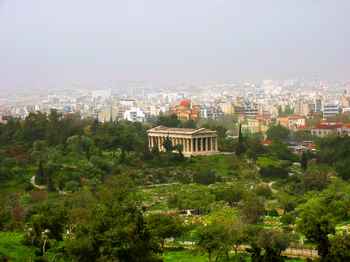 |
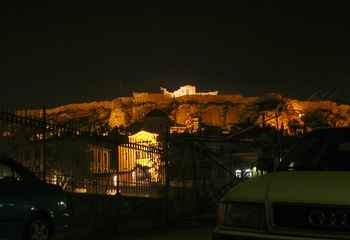 |
| Temple of Hephaestus (just below the Acropolis). | A view of the Acropolis at night. |
As you walk around the unwelcoming streets of Athen's urban sprawl, you can get a glimpse of the Acropolis from almost anywhere which inevitably would make you feel happy to be in Athens. Even more uplifting was to actually climb to the top of the Acropolis where you can see some of Athen's glorious ancient buildings, breathtaking even if they are only a shadow of their former selves.
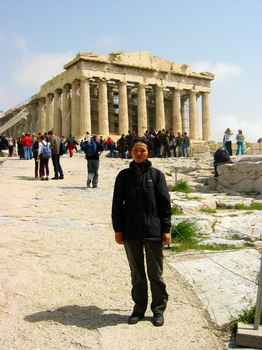 |
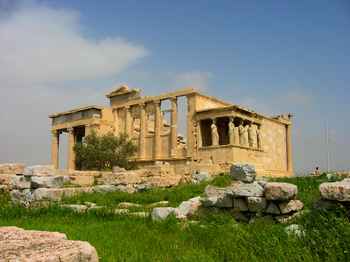 |
| The Parthenon on the top of Athen's Acropolis. | Monument of Agrippa on Athen's Acropolis. |
From Athens, we hopped on a three hour bus to the city of Delphi which was home to ancient Greece's most famous oracle. There was a large temple to Apollo here, and the priestess (or oracle) of Delphi could be asked to answer questions about things such as what the outcome of a battle would be. City states vied for Delphi's favour, and as a result, Delphi's riches grew and Delphi became embroiled in the political battles of the ancient Greek city states.
 |
| View from Delphi. |
Delphi is located in some beautiful mountain scenery which makes a visit to Delphi worth it in its own right. While it is possible to visit Delphi as a day trip from Athens, the town cleverly shuts down the sites at about 2:30pm to make such a trip difficult. Given its beautiful location, we were planning on spending the night here anyway.
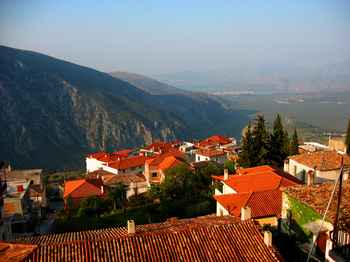 |
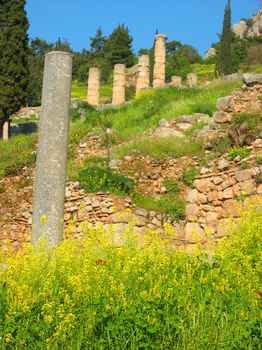 |
| View from our hotel in Delphi (you can see down to the Gulf of Corinth). | Ruins of the Temple of Apollo at Delphi. |
We took a late morning bus to get here, and decided to try and see the ruins in the early morning of the next day ... before the tour busses start to arrive. We woke up the next morning to a beautiful sunny day as we set out to explore the navel of the world. In Greek mythology, Zeus unleashed two eagles from opposite sides of the earth, and they met in the center of Delphi which the Greeks considered to be the center (or navel) of the world.
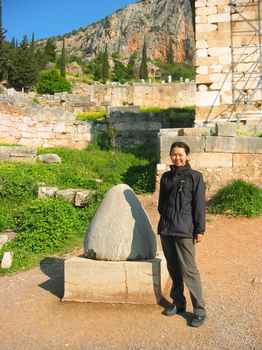 |
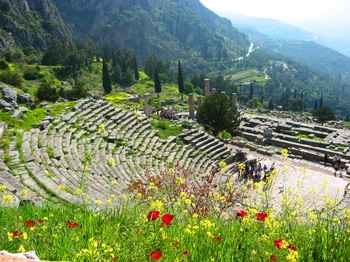 |
| The point marking the "navel of the world". | Delphi theater. |
As you wander around the ruins, you see the ruins of monuments and treasuries built and maintained by the individual city states (such as Athens, Thebes, etc.). There is a large theater that was used for a plays during a festival that took place every four years, as well as a large temple to Apollo to whom Delphi was dedicated. The oracle of Delphi was believed to be the mouth of Apollo, and she received her visions by inhaling fumes from a crack in the temple.
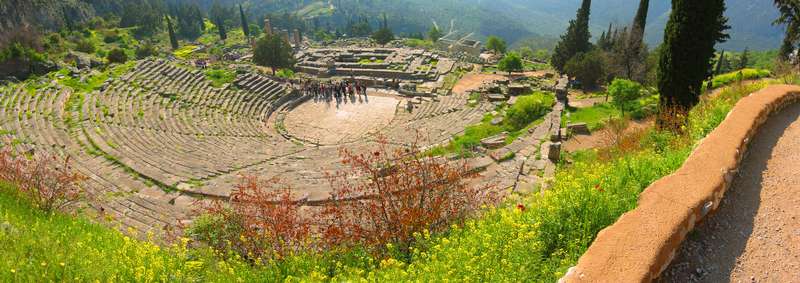 |
| Theater in Delphi with the ruins of the temple of Apollo in the background. |
Our morning peace and quiet at the ruins were soon broken as the tour groups began to arrive, and at that point we took refuge in Delphi's small but interesting museum.
 |
| Delphi stadium. |
That afternoon, we checked out of our hotel, and boarded a bus bound for Larissa where we would spend the night before catching a morning train to Kalambaka in a region known as Meteora. Meteora is famous for its Byzantine monasteries that were built on the top of large pillar like rock formations. As the Byzantine empire began to crumble, the monks decided to find solitude and safety at the top of Meteora's pinnacles. Today, stairs have been chiseled into the side of the cliffs to allow access, but I have no idea how the first priests managed to climb to the top and lug building equipment with them. Until the turn of the century, when the stairs were built, people were hoisted up to the top of the monasteries using a winch and a net.
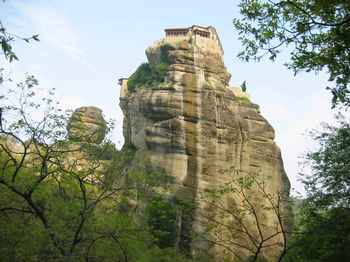 |
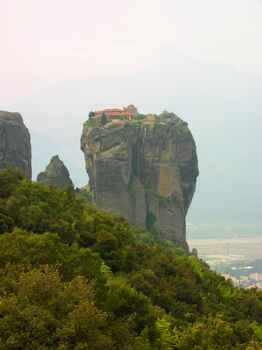 |
| Meteora monastery of Varlaam. | Meteora monastery of Agias Triados. |
From our base in Kalambaka, we hiked our way up into the mountains as our jaw dropped at the breathtaking scenery around us. Even without the monasteries, Meteora would be well worth a visit for its natural beauty. Apparently geologists are still trying to figure out what caused the strange rock formations which almost look like the crumbling pillars from some ancient Greek temple that stood 600 meters (2000 feet) tall.
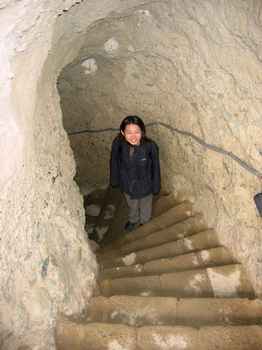 |
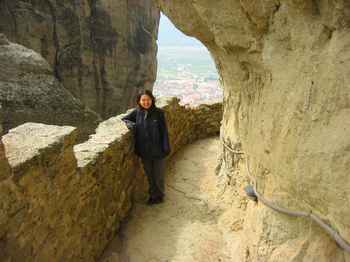 |
| Climbing up to the Agias Triados monastery. | Continuing the climb to the monastery. |
The nearest monastery to our temple was the Agias Triados, so we struggled up the steep paths to the base of the monastery. At that point, you entered a small man made cave which led to a small trail carved in the side of the cliff which wound its way to the top of the monastery. The views from the top were spectacular, and for a small fee you could look around inside the church. While I expected a business like reception as a monk would collect our money and hand over a ticket, what we received was quite the opposite.
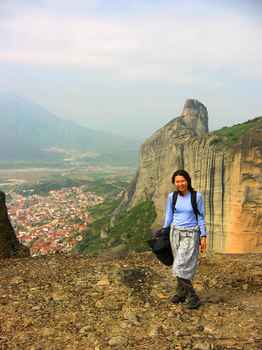 |
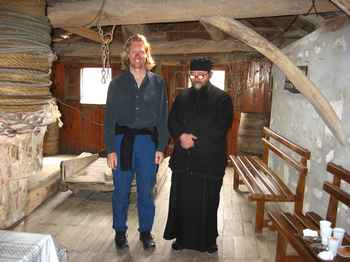 |
| Hitomi in her required skirt on top of the Agias Triados monastery. | Ron with Father John. |
We were greeted by a very friendly Father John who spoke just a few words of English. He collected our money, and asked us to see the "very nice panorama", and the "very nice church" before coming back to join him for a cup of coffee. Before we left, he handed us a delicious sweet that tasted something like Turkish delight. When we came back, Father John served us a Greek coffee and a plate of cookies along with some stewed raisins.
He apparently likes coffee very much, as about half a dozen times during our conversation, as we would pick up our coffee, he would spout "Greek coffee ... very nice!".
He then tried to talk to us and learn a little about us. It was a little unnerving as he would ask questions with his head inches away from your own as apparently his eyesight wasn't too good (and it was clear there was something wrong with his left eye). When we explained that we were married, he asked us if we had any children. When we said not yet, he did a "Hail Mary", and with his finger still pointing at himself said "four children". I was a little surprised that a monk had children, although I had read that while orthodox priests were not allowed to marry, married men could be ordained into the priesthood.
He continued to ask questions of us, and it turned out that he was fairly well traveled (many times to New York and a few times to Canada). I decided to ask him a few questions and found out that he had been a monk here for 28 years. I then tried to ask him about his children. After about one minute of confused interaction, it dawned on me that I had misinterpreted what he had said. He didn't say "four children", but had said "for children". He was giving us a blessing to wish us luck at having our own children.
He then asked us about our profession, and when I said I worked with computers, he looked a little dejected and said that the monastery had no money, and very few tourists came so they couldn't get much money that way. Being poor, the monastery couldn't afford a computer. At this point, he mentioned that he too didn't have a lot of money, and couldn't even replace his watch that broke a few weeks ago. This led to a bit of his life story which started with him explaining that he had eye cancer a while back. To prove his point, he removed his glasses and lifted up his eyelid to show that there was no eyeball within the left eye socket. He then explained that 29 years ago, he had lost his parents and siblings in an car accident, and it was clear what encouraged him to enter the priesthood.
I wasn't quite sure what to say at this point, and the lull in conversation soon ended as we decided that we needed to leave soon to arrive at the next monastery before it closed for lunch. While Father John was a little unusual, he was also very sweet and seemed to enjoy talking to the tourists.
 |
| Meteora rock formations. |
We continued along a circuit that toured the different monasteries, and found the remaining monasteries that we entered to be a much more normal experience with a ticket vendor and souvenir stands inside. We arrived at the biggest of the monasteries just as it closed around 6pm, and decided to make the hike into a loop trip by taking a hiking trail marked on the Lonely Planet map down to a city called Kastriki. The trail started a little rough, but I figured that it had to get better. The trail involved a short hike up to a saddle, and then a decent down the other side of about 400 meters in altitude.
The trail didn't get much better as we struggled through thorny raspberry bushes and went down near vertical sections on our hands and knees praying that we didn't slip. I began to get angry at the Lonely Planet for having such a nonexistant trail on their maps. We began to wish that we had never started the trail, but as we had already descended a fair distance, we didn't feel like retracing our steps. The trail was really hard to follow (if there was one at all), and numerous times we reached a dead end and had to climb back up a bit to traverse across and find a place that seemed safe to climb down. As we got near the bottom, it leveled out a bit, and there seemed to be a clear trail to follow. We followed the trail along a contour to the right and then started to descend down another gully. After about 10 minutes or so it seemed we were about to get to the bottom, and I began to cheer up. However, moments before we reached the bottom, the trail dead-ended at a 10m cliff with sheer walls on either side. It was clear that there was absolutely no way down!
At this point, it was hard to resist the urge to panic. It was getting late, and I didn't think we could make it back up to the top before dark, and we didn't think to bring our flashlights with us. Parts of the climb up were sections that we kind of jumped down, and I wasn't even positive that we would be able to make it up (especially given our weary state). I didn't want Hitomi to panic, so I hid my worries and tried to reassure her that everything was going to be alright.
We wandered back up to the contour we had followed, and at that point I looked back at the map. I realized that the gully we had descended was not the right gully, and we now had a choice to make. By far the fastest route down, if possible, was to continue to work down the cliff and hope we could make it out. However, if that also resulted in a dead-end, we would definitely not get back up before dark and I didn't relish the possibility of spending the night outside (it was still getting very cold at night). We decided to try to descend the other gully.
The trail continued to be very hard to follow, although was largely the same as it was above. A few false dead-ends, more thorn bushes, and more rocks to scramble down. However, within about 15 minutes we reached the meadow at the base of the cliffs and we were extremely relieved. We were now at the outskirts of the town of Kastriki. We still had about 5km or so to hike back, but even though we were exhausted and it was getting dark, this didn't seem very bad at all. At least we would be sleeping in our warm beds that night.
When we got back to the hotel, we ordered a Greek salad, chicken grilled in front of the fireplace, and washed it down with some delicious wine made by our host.
Despite the misadventure, we had an amazing day, and Meteora was definitely the highlight of our travels in Greece. In fact, we did the entire hike again the next day in reverse (although this time skipping the detour along the "hiking trail").
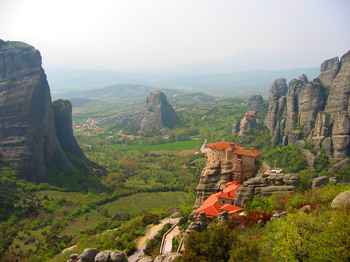 |
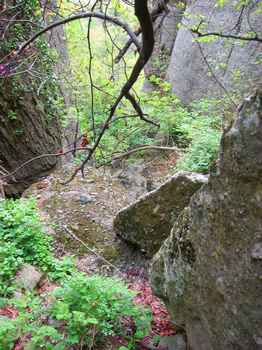 |
| Meteora's monastery of Agias Varvaras Rousanou. | Our "hiking trail" just before it lead off a 10m high cliff. |
From Meteora, we bussed and boated our way westwards to the island of Corfu. Corfu was also formerly under the control of Venice, and as it was never conquered by the Turks and escaped much of the carnage of World War II, it still has a distinctly Venetian feel. The buildings and passageways reminded me of Venice without the canals. After a couple of days relaxing in Corfu, we took an overnight ferry to the Italian port of Bari where we arrived on the 13th of April.
Ron & Hitomi
(Click here to go back to www.rangda.com, or here to go back to www.rangda.com/travel/ron)